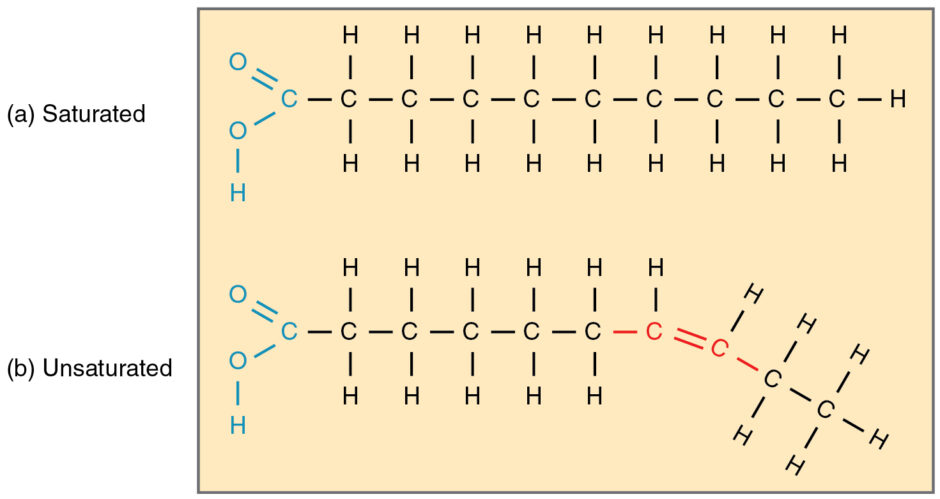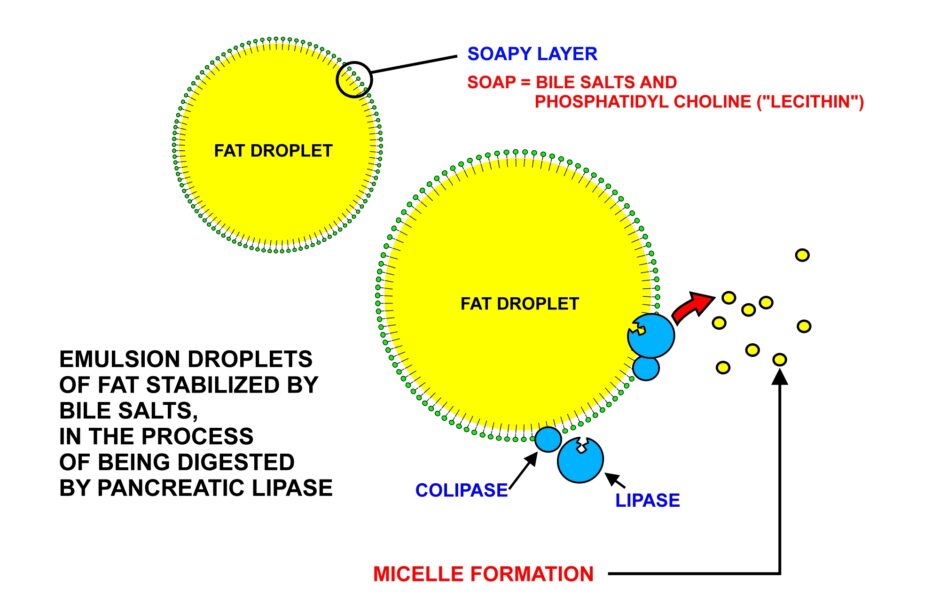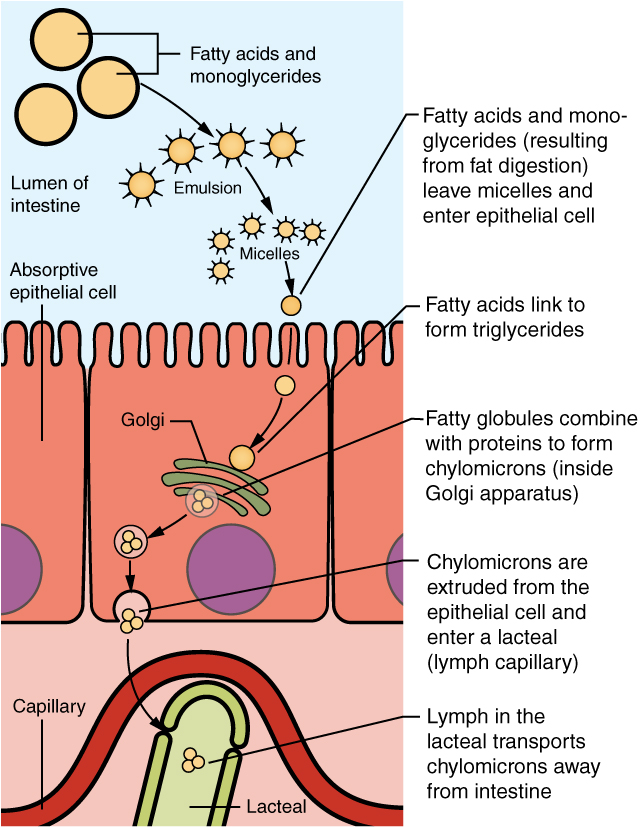- 📖 Geeky Medics OSCE Book
- ⚡ Geeky Medics Bundles
- ✨ 1300+ OSCE Stations
- ✅ OSCE Checklist PDF Booklet
- 🧠 UKMLA AKT Question Bank
- 💊 PSA Question Bank
- 💉 Clinical Skills App
- 🗂️ Flashcard Collections | OSCE, Medicine, Surgery, Anatomy
- 💬 SCA Cases for MRCGP
To be the first to know about our latest videos subscribe to our YouTube channel 🙌
Introduction
Fatty acids are formed from the digestion of lipids (the technical term for fats).
In contrast to proteins and carbohydrates, the digestion of lipids is complex due to the body’s intestinal environment being hydrophilic, and lipids being hydrophobic molecules. Fatty acids are absorbed and used by the body to form cells and fuel stores.
Structure
Lipids comprise two separate molecules (fatty acids and glycerol) which bond together to form a triglyceride, commonly known as dietary fat.1
Fatty acids
Fatty acids are hydrocarbon chains that are attached to one carboxyl group. Therefore, fatty acids are classified as carboxylic acids in chemical terms.2
Classification of fatty acids
There are three classes of fatty acids:1
- Saturated: the hydrocarbon chain has no double bonds (e.g. palmitic and stearic acid)
- Monounsaturated: the hydrocarbon chain has one double bond (e.g. oleic acid)
- Polyunsaturated: the hydrocarbon chain has more than one double bone (e.g. arachidonic and linoleic acid)

Length of fatty acids
In addition to classification by their saturation, fatty acids can also be classified based on their length:2
- Short-chain fatty acids (SCFA): 2-5 carbon molecules
- Medium-chain fatty acids (MCFA): 6-12 carbon molecules
- Long-chain fatty acids (LCFA): 12-21 carbon molecules
- Very long-chain fatty acids (VLCFA): 22 or more carbon molecules
Glycerol
Glycerol is a simple alcohol molecule which has three hydroxyl groups. Glycerol bonds with three fatty acid chains via esterification to form a triglyceride.1,2
Triglycerides
Triglycerides are esters in which glycerol and three fatty acid chains have linked. They are named based on which fatty acid chains they are comprised of:1,2
- Oleodistearin: glycerol + 1 oleic acid chain + 2 stearic acid chains
- Tristearin: glycerol + 3 stearic acid chains

Nutrition
Digestion3
As lipids are hydrophobic, lipid digestion is more complex than that of carbohydrates and proteins.
The digestion of lipids starts in the mouth and stomach via lingual and gastric lipases. However, these lipases poorly digest fats.
Once the lipids pass into the small intestine, bile which is produced by the liver and stored in the gallbladder is secreted. The bile emulsifies the fats into much smaller micelles, increasing the surface area.
This increased surface area and smaller portions help the intestinal lipases to hydrolyse the micelles, thus breaking the lipids into fatty acids, monoglycerides and cholesterol.

Absorption3
The products formed from the lipids are released into the apical membrane and move into the cells that line the intestine, called enterocytes. As the cell membrane is lipophilic, this movement is called diffusion.
Once inside the cell, the products are re-esterified, returning to the original lipid formation. The lipids are then packaged together to form a chylomicron. Once formed, chylomicrons are too large to enter the vascular circulation, so they travel via the lymphatic system.

Clinical relevance: fat malabsorption4
Multiple conditions can cause fat malabsorption due to problems with the hydrolysis of fats, digestion and uptake of lipid products and the lymphatic transport of nutrients.
Typical symptoms of fat malabsorption include:
- Chronic diarrhoea
- Steatorrhea: foul-smelling, pale, bulky and greasy stools
- Unexplained vitamin and mineral deficiencies
- Abdominal bloating
- Gas
The diagnosis of fat malabsorption is generally made based on the patient’s history. However, stool testing and endoscopy should be considered to confirm the diagnosis.
It is best to think about fat malabsorption in terms of where the problem causing the malabsorption is located. Common conditions that can cause fat malabsorption include:
- Biliary system: bile duct obstruction preventing bile flow (e.g. choledocholithiasis, primary biliary cholangitis, cholangiocarcinoma)
- Pancreas: exocrine insufficiency preventing digestion (e.g. cystic fibrosis, pancreatitis, pancreatic adenocarcinoma)
- Intestines: reduced surface area for absorption, either intestinal wall (e.g. Crohn’s disease, ulcerative colitis, coeliac disease) or intestinal lumen (e.g. short bowel syndrome, bowel resections, infections such as giardiasis)
Dietary fat
Different foods have different proportions of unsaturated and saturated fatty acids, each with different impacts on health.
Types of fat
Diets high in excess saturated fat, normally from animal-sourced foods (dairy and beef), are accepted as having a causal relationship with increased blood cholesterol and increased rates of cardiovascular disease.
Foods such as pork, eggs, poultry and seafood have higher amounts of unsaturated fats. Diets containing higher amounts of unsaturated fats, commonly known as “good” fats, are associated with better cardiovascular health.
Energy density
Of the three major macronutrients, fats have the highest energy density. Fats contribute 37kj for every 1g consumed.
Key points
- Fatty acids are formed from the digestion of lipids (the technical term for fats)
- Fatty acids are hydrocarbon chains that are attached to one carboxyl group
- There are multiple types of fats: saturated, monounsaturated and polyunsaturated
- Fats are hydrophobic, meaning that digestion and absorption is a more complex process than for other micronutrients
- Malabsorption of fat generally presents with diarrhoea, steatorrhea, bloating and gas
- Fats are the most energy-dense macronutrient
Editor
Dr Chris Jefferies
References
Text references
- Ib.bioninja.com.au. 2022. Types of Fatty Acids | BioNinja. [online] Available from: [LINK]
- Library.med.utah.edu. 2022. Fatty Acids — Classification of Fatty Acids. [online] Available from: [LINK]
- Medicine LibreTexts. 2022. 5.4: Digestion and Absorption of Lipids. [online] Available from: [LINK]
- MSD Manual Professional Edition. 2022. Overview of Malabsorption – Gastrointestinal Disorders – MSD Manual Professional Edition. [online] Available from: [LINK]
- MSD Manual Consumer Version. 2022. Carbohydrates, Proteins, and Fats – Disorders of Nutrition – MSD Manual Consumer Version. [online] Available from: [LINK]
Image references
- Figure 1. OpenStax College. Fatty Acids Shapes. License: [CC BY]
- Figure 2. OpenStax College. Triglycerides. License: [CC BY]
- Figure 3. OpenStax College. Emulsification formation. License: [CC BY]
- Figure 4. OpenStax College. Lipid absorption. License: [CC BY]




